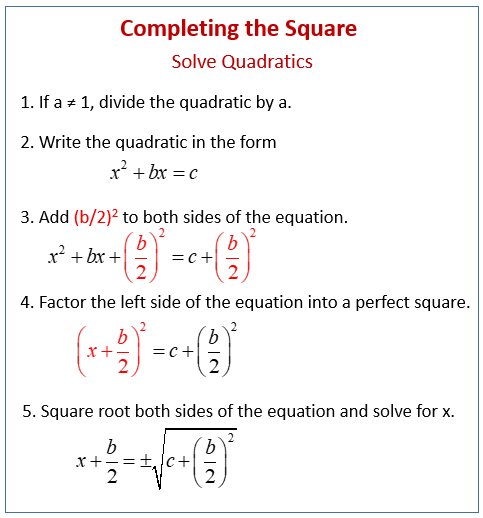Completing the Square to Solve Quadratic Equations
Related Topics:
More Lessons for Grade 6
Math Worksheets
Examples, solutions and videos to help GCSE Maths students learn how to complete the square in order to solve quadratic equations.
Completing the Square
Completing the square is an algebraic technique used to solve quadratic equations. The core idea is to transform a standard quadratic expression into a perfect square trinomial, which can then be solved by taking the square root.
The following diagram gives the steps for the completing the square method for solving quadratic equations. Scroll down the page for more examples on using the completing the square method.

Algebra Worksheets
Practice your skills with the following worksheets:
Printable & Online Algebra Worksheets
The Goal of Completing the Square
The goal is to rearrange the quadratic equation so that one side is a perfect square trinomial, like (x + k)2 or (x − k)2. Once in this form, you can take the square root of both sides to solve for x
How to solve quadratic equations by completing the square?
- If a ≠ 1, divide each term of the quadratic equation by a.
- Write the quadratic in the form
x2 + bx = c - Add (b/2)2 to both sides of the equation.
- Factor the left side of the equation. It should be a perfect square.
- Square root both sides of the equation and solve for x.
When is Completing the Square Useful?
If a quadratic equation cannot be easily factored, or if its solutions are irrational or complex, completing the square will still work to find them.
Videos
GCSE Maths - Quadratic Equations 6 (Completing the Square) Higher Mathematics (IGCSE)
Quadratic Equation Completing the Square GCSE Maths revision Exam paper practice & help
Completing the square for a quadratic equation where the coefficient of x2 is greater than 1
This tutorial runs through completing the square for a quadratic expression where the coefficient of x squared is greater than 1.
Completing the Square when the Leading Coefficient is not 1
Try out our new and fun Fraction Concoction Game.
Add and subtract fractions to make exciting fraction concoctions following a recipe. There are four levels of difficulty: Easy, medium, hard and insane. Practice the basics of fraction addition and subtraction or challenge yourself with the insane level.

We welcome your feedback, comments and questions about this site or page. Please submit your feedback or enquiries via our Feedback page.